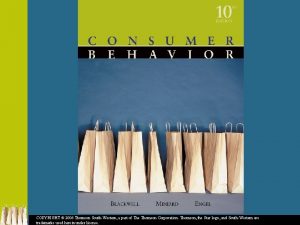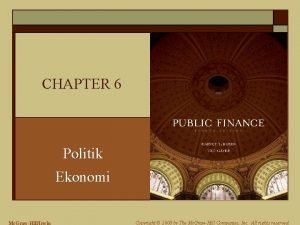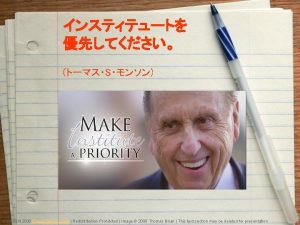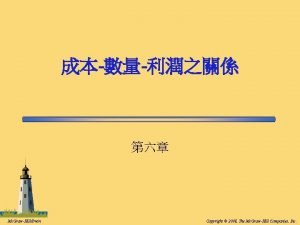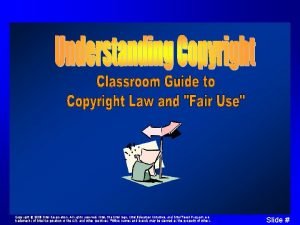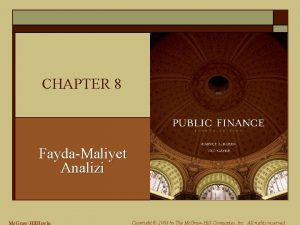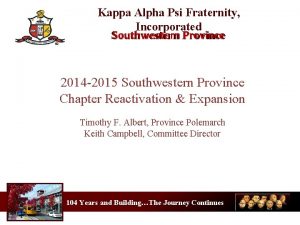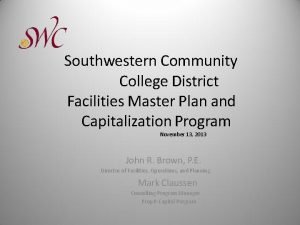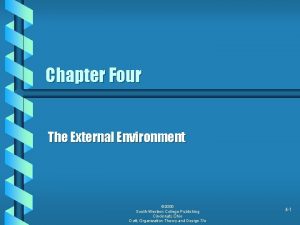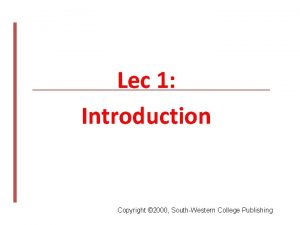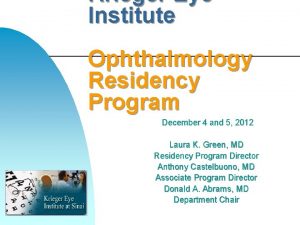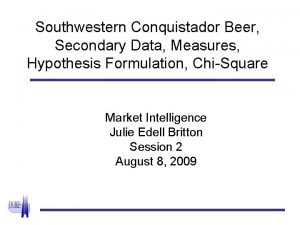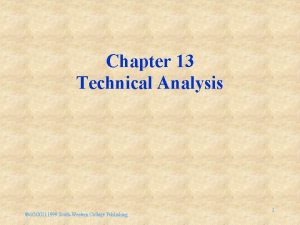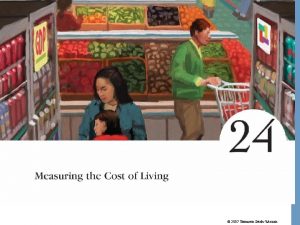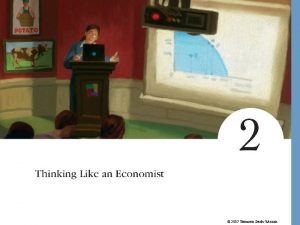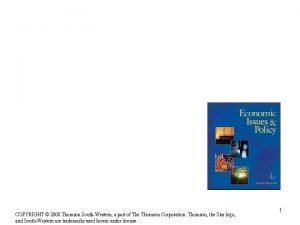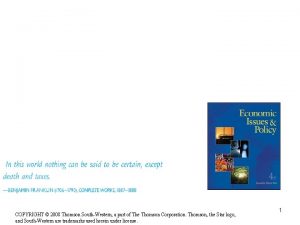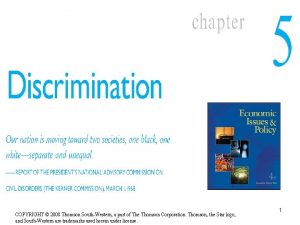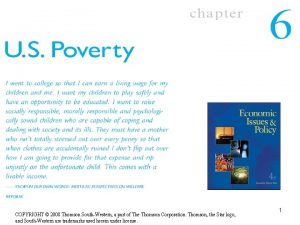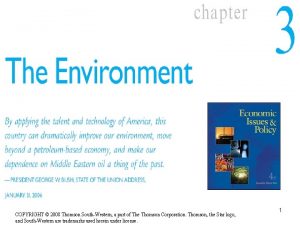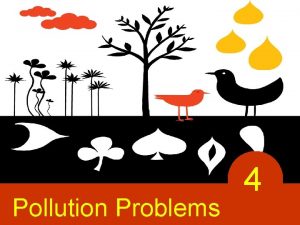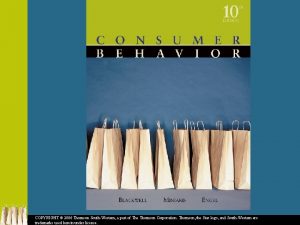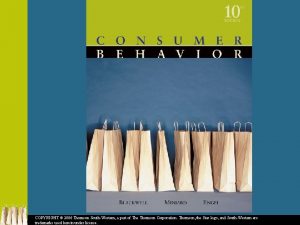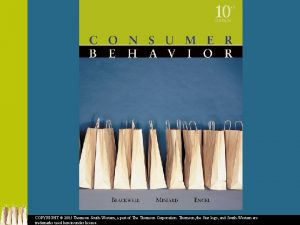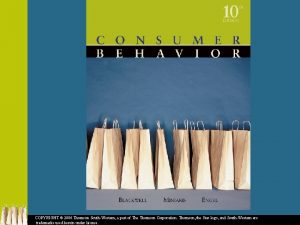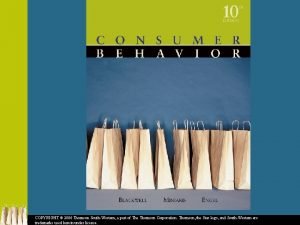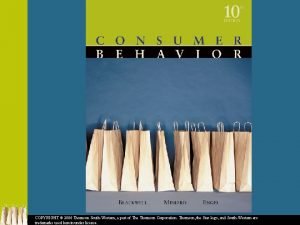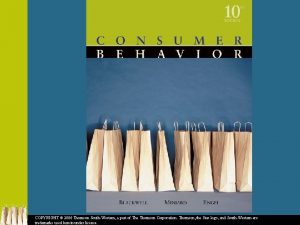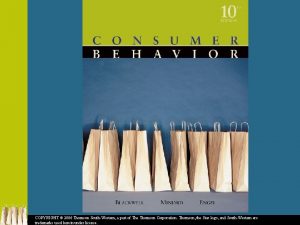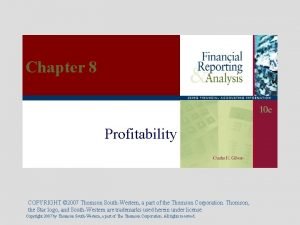COPYRIGHT 2008 Thomson SouthWestern a part of The

































- Slides: 33

COPYRIGHT © 2008 Thomson South-Western, a part of The Thomson Corporation. Thomson, the Star logo, and South-Western are trademarks used herein under license. 1

Crime: Facts and Figures • One murder is committed every 33 minutes • One rape or sexual assault is committed every two minutes • One burglary is committed every 10 seconds • One theft is committed every two seconds • 62 women are victimized by an intimate person every hour • A person is killed in an alcohol-related traffic crash every 41 minutes • Identity theft is reported every six minutes • Three women and/or men become victims of stalking every minute • A child is abused and/or neglected every 36 seconds 2 -2 2

Violent Crime • Crime is any action that is forbidden by law and carries criminal penalties • Violent crime includes: – – Murder Forcible rape Robbery Aggravated assault 2 -3 3

Violent Crime in the United States 2 -4 4

Violent Crime in the United States (cont. ) 2 -5 5

Crime Prevention as a Public Good • Police activity and other crime prevention measures are examples of public goods and services 2 -6 6

Characteristics of Public Goods and Services • Indivisible – Impossible to divide into units sufficiently small enough to be sold in private markets • Nonrivalrous – Use by one person does not prevent use by others • Nonexcludable – Benefits cannot be kept from persons who do not pay for the goods’ provision in a private market • Subject to the free rider problem – Individuals that do not pay their share for a good or service nevertheless enjoy its benefits 2 -7 7

Evaluation by Cost-Benefit Analysis • Study that compares the costs and benefits of a policy or program • Appropriate method to evaluate government policy – Activity is justified only if benefits are greater than costs • Net benefits – The excess of benefits over costs 2 -8 8

Benefits and Costs of Crime Prevention Activities • Benefits: – Value of property damage prevented – Medical expenses, psychological trauma, loss of income, and other expenses not incurred from criminal assaults • Costs: – Costs of equipment – Salaries and fringe benefits of police, court, and corrections personnel – Costs of administering the system 2 -9 9

Production Possibilities Curve for Crime Prevention 2 -10 10

Incarceration Rates 2 -11 11

Decreasing Violent Crimes Against Persons • Studies with age-adjusted data find few benefits and great costs associated with higher incarceration rates • Studies without age adjustments find that the benefits of increased incarceration greatly exceed the costs – Thus, conflicting research methods lead to uncertain conclusions 2 -12 12

Prison Overcrowding • Despite falling crime rates in 1990 s to the present, the prison population soared due to: 1. Establishment of mandatory minimum sentences for drug violations and other offenses • More than half (55 percent) of federal prisoners are drug offenders 2. Truth in Sentencing provision in a 1994 federal crime bill 3. Adoption by federal government and half the states of “three strikes and you’re out” laws • Require sentences of life for third conviction of certain crimes 2 -13 13

White-Collar Crime • Crime by business managers, as well as their supporting structure of boards of directors, accountants, investment bankers, lawyers, and other professionals, who engage in dishonest practices for financial gain • Growing in epidemic proportions – – Enron World. Com Tyco Global Crossing 2 -14 14

Should Drugs be Legalized? • One of the most controversial topics in the issue of drug use, and in the entire field of crime and criminology today, is legalization or decriminalization of illegal drugs 2 -15 15

The Argument Against Legalization of Drugs • Based mainly on: 1. Adverse public health consequences of drugs 2. Expected increase in drug-related social problems 3. Successes of the War on Drugs 4. Invasion of civil liberties 2 -16 16

The Argument for Legalization of Drugs • Based on: 1. Efforts to restrict supply of drugs have largely failed 2. Link between illegal drugs and crime 3. Drugs may contribute to corruption 4. Drug laws may contribute to discrimination 5. Drug enforcement may violate our constitutional rights 6. Financial and opportunity costs of drug enforcement 7. Health consequences of drug policies 8. Many benefits of the legalization of drugs 2 -17 17

The Effect of Legalization on the Demand for Drugs 2 -18 18

The Effect of Legalization on the Supply of Drugs 2 -19 19

Inelastic Demand vs. Elastic Demand • Inelastic demand – Buyers are relatively unresponsive to changes in price • Elastic demand – Buyers are relatively responsive to changes in price 2 -20 20

Regulation through Economic Policies • Economists who favor drug legalization or decriminalization often argue: – Greater percentage of government expenditures on drug-related programs should be directed toward demand-side treatment and education programs – System of excise taxes (tax applied to purchase of a specific good or service) can be levied on legal drugs 2 -21 21

Excise Taxes on Drugs • Would decrease supply of the drug, since excise tax is an additional cost of production – Decrease in supply caused by excise tax causes an increase in drug’s price and a decrease in its use • Level of tax should be correlated with the drug’s harmful public health effects • Revenues from excise tax could be earmarked for treatment and education programs 2 -22 22

Legalization of Other Victimless Crimes • Economic analysis of legalization of drugs can also be applied to other so-called victimless crimes – Pornography – Prostitution • Equilibrium quantity would undoubtedly increase with legalization, but regulation and taxation for regulatory purposes might well be more efficient than prohibition – But social issues related to legalization may outweigh economic issues 2 -23 23

Diversity and Crime • Number of women in prison has increased at nearly double the rate of men since 1980 • Nationally, 93, 000 women in prison is more than seven times number in 1980 • A third of women prisoners are incarcerated for a drug offense • Two-thirds of people in prison consist of racial and ethnic minorities 2 -24 24

Hate Crimes • The FBI defines a hate crime as a criminal offense committed against someone that is motivated, in whole or in part, by the offender’s bias based on race, religion, sexual orientation, or ethnicity 2 -25 25

Global Dimensions of Crime 2 -26 26

The Economic Left and the Economic Right • THE ECONOMIC LEFT (Liberal) – Favor criminalization and prohibition of drug use and other victimless crimes • THE ECONOMIC RIGHT (Conservative) – Support legalization of drugs and other victimless crimes – Value efficiencies attained when market forces shift demand supply curves if legalization occurs – Prefer excise taxes and other market approaches to account for harmful community effects of drugs and other victimless crimes, instead of prohibition of activity itself 2 -27 27

Appendix: Elasticity • Elasticity of demand is the responsiveness of buyers (in terms of buying decisions) to changes in the price of the product • Elasticity coefficient: Percentage Change in Quantity Demanded Percentage Change in Price – If demand is elastic: • Coefficient will have an absolute value greater than 1 • Any percentage change in price causes a larger percentage change in quantity demanded – If demand is inelastic: • Coefficient’s absolute value will be some fraction less than 1 • Any percentage change in price causes a smaller percentage change in quantity demanded 2 -28 28

Appendix: Elasticity (cont. ) • Graphs on the next slide show theoretical extremes of elasticity: – Graph on the left is a perfectly inelastic demand curve • Regardless of any price change, quantity demanded does not change • Perfectly inelastic demand curves are always drawn as vertical lines, and they have an elasticity coefficient equal to zero – Graph on the right is a perfectly elastic demand curve • Although price does not vary, quantity demanded will vary infinitely • Perfectly elastic demand curves are always horizontal lines • Most demand curves are neither perfectly elastic nor perfectly inelastic 2 -29 29

Appendix: Elasticity (cont. ) 2 -30 30

Appendix: Elasticity (cont. ) • The more typical case of elasticity is related to both the location of the curve on the graph and its slope – If two demand curves intersect so that their location on the graph is very close, compare their elasticity in the region near their intersection by comparing their slopes • The flatter (closer to horizontal) curve will be more elastic • The steeper (closer to vertical) curve will be more inelastic 2 -31 31

Appendix: Elasticity (cont. ) 2 -32 32

Appendix: Elasticity (cont. ) • Elasticity has interesting implications when an excise tax is imposed on the sale of a good or service – In general, we say that the burden of the tax falls most heavily on that group (consumers or suppliers) with the more inelastic curve 2 -33 33
 Thomson southwestern
Thomson southwestern 2008 2008
2008 2008 Copyright 2008
Copyright 2008 Copyright 2008
Copyright 2008 Redistribution prohibited
Redistribution prohibited Copyright 2008
Copyright 2008 Copyright 2008
Copyright 2008 Copyright 2008
Copyright 2008 Copyright 2008
Copyright 2008 Southwest province kappa psi
Southwest province kappa psi Catherine carpenter southwestern
Catherine carpenter southwestern Swp kappa alpha psi
Swp kappa alpha psi Kappa alpha psi southwestern province
Kappa alpha psi southwestern province Southwestern college publishing
Southwestern college publishing William puder kappa alpha psi
William puder kappa alpha psi Kappa alpha psi southwestern province
Kappa alpha psi southwestern province Southwestern community college
Southwestern community college Symplicity rutgers
Symplicity rutgers Southwestern college cincinnati ohio
Southwestern college cincinnati ohio Century 21 southwestern accounting
Century 21 southwestern accounting South-western college publishing
South-western college publishing Krieger eye institute northwest hospital
Krieger eye institute northwest hospital Kappa alpha psi k
Kappa alpha psi k Conquistador beer case
Conquistador beer case Southwestern college publishing
Southwestern college publishing Các châu lục và đại dương trên thế giới
Các châu lục và đại dương trên thế giới Thế nào là hệ số cao nhất
Thế nào là hệ số cao nhất Hệ hô hấp
Hệ hô hấp Tư thế ngồi viết
Tư thế ngồi viết đặc điểm cơ thể của người tối cổ
đặc điểm cơ thể của người tối cổ Cái miệng bé xinh thế chỉ nói điều hay thôi
Cái miệng bé xinh thế chỉ nói điều hay thôi Mật thư anh em như thể tay chân
Mật thư anh em như thể tay chân Bổ thể
Bổ thể Glasgow thang điểm
Glasgow thang điểm
